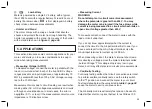
30
milliseconds. When a change is detected, the beeper tone
is „stretched“ to last at least 1/4 second so you can hear
it and detect both shorts and opens. This can be a valuable
troubleshooting aid when looking for intermittents associ-
ated with cables, connections, switchers, relays, etc. If the
test value is very close to the threshold, erratic beeps can
also occur due to environmental electrical noise (EMI).
– Measuring Resistance
CAUTION
Turn off power on the test circuit and discharge all
capacitors before attempting in circuit resistance
measurements. If an external voltage is present across
a component, it will be impossible to take an accurate
measurement of the resistance of that component.
The meter measures resistance by passing a known cur-
rent through the external circuit or component, measuring
the voltage drop, and calculating the resistance using
Ohm‘s Law (Ω = V/A). Remember, the resistance displayed
by the meter is the total resistance through all possible
paths between the probes. This explains why in-circuit
measurement of resistors does not often yield the ohms
value indicated by the resistor‘s colour code.
The resistance in the test leads can diminish accuracy on
the lowest (200 Ohm) range. The error is usually 0.1 to 0.2
Ohms for a standard pair of test leads. To determine the
error, short the test leads together and read the resistance
of the leads.
When measuring resistance, be sure that the contact bet-
ween the probes and the circuit under test is good. Dirt,
oil, solder flux, or other foreign matter seriously affect
resistance.
Most in-circuit resistance measurements can be made
without removing diodes and transistors from the circuit.
The full scale measurement voltage produced on ranges
below 20 MΩ does not forward-bias silicon diodes or tran-
sistor junctions enough to cause them to conduct.
Use the highest range you can (except 20 MΩ) to minimize
the possibility of turning on diodes or transistor junctions.
Full-scale measurement voItage in the 20 MΩ range does
forward-bias a diode or transistor enough to cause it to
conduct.
– Diode Testing
To perform a diode or transistor junction test plug the test
leads into the VΩ (positive) and COM inputs, turn the rotary
switch to
, and connect the test leads across the
diode(s).
In diode test, voItage is developed across the component(s)
by a test current (approximately 1 mA with the test leads
shorted) from the meter. Voltage is read on a single 0 to
+ 2.000 V range that can measure up to five silicon diode
or transistor junctions in series. For a silicon diode, the ty-
pical forward voltage should be about 0.6 V. Voltage greater
than 2.000 V or open test leads produce an overload
(
) reading. If the digital reading is the same in both
















































